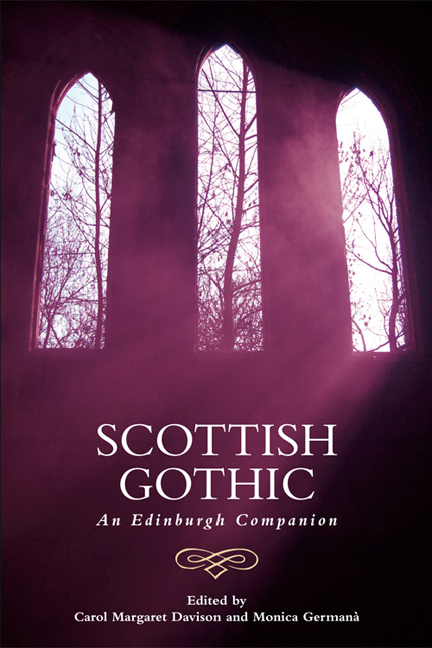Book contents
- Frontmatter
- Contents
- Acknowledgements
- 1 Borderlands of Identity and the Aesthetics of Disjuncture: An Introduction to Scottish Gothic
- 2 ‘The Celtic Century’ and the Genesis of Scottish Gothic
- 3 The Politics and Poetics of the ‘Scottish Gothic’ from Ossian to Otranto and Beyond
- 4 Robert Burns and the Scottish Bawdy Politic
- 5 Scottish Gothic Drama
- 6 Scottish Gothic Poetry
- 7 Calvinist and Covenanter Gothic
- 8 Gothic Scott
- 9 Gothic Hogg
- 10 ‘The Singular Wrought Out into the Strange and Mystical’: Blackwood's Edinburgh Magazine and the Transformation of Terror
- 11 Gothic Stevenson
- 12 J. M. Barrie's Gothic: Ghosts, Fairy Tales and Lost Children
- 13 The ‘nouveau frisson’: Muriel Spark's Gothic Fiction
- 14 Scottish Gothic and the Moving Image: A Tale of Two Traditions
- 15 New Frankensteins; or, the Body Politic
- 16 Queer Scottish Gothic
- 17 Authorship, ‘Ghost-filled’ Islands and the Haunting Feminine: Contemporary Scottish Female Gothic
- Notes on Contributors
- Index
6 - Scottish Gothic Poetry
Published online by Cambridge University Press: 20 December 2017
- Frontmatter
- Contents
- Acknowledgements
- 1 Borderlands of Identity and the Aesthetics of Disjuncture: An Introduction to Scottish Gothic
- 2 ‘The Celtic Century’ and the Genesis of Scottish Gothic
- 3 The Politics and Poetics of the ‘Scottish Gothic’ from Ossian to Otranto and Beyond
- 4 Robert Burns and the Scottish Bawdy Politic
- 5 Scottish Gothic Drama
- 6 Scottish Gothic Poetry
- 7 Calvinist and Covenanter Gothic
- 8 Gothic Scott
- 9 Gothic Hogg
- 10 ‘The Singular Wrought Out into the Strange and Mystical’: Blackwood's Edinburgh Magazine and the Transformation of Terror
- 11 Gothic Stevenson
- 12 J. M. Barrie's Gothic: Ghosts, Fairy Tales and Lost Children
- 13 The ‘nouveau frisson’: Muriel Spark's Gothic Fiction
- 14 Scottish Gothic and the Moving Image: A Tale of Two Traditions
- 15 New Frankensteins; or, the Body Politic
- 16 Queer Scottish Gothic
- 17 Authorship, ‘Ghost-filled’ Islands and the Haunting Feminine: Contemporary Scottish Female Gothic
- Notes on Contributors
- Index
Summary
The first sentence of the Preface to Émile Mâle's magisterial study of religious art in thirteenth-century France, The Gothic Image, reads: ‘To the Middle Ages, art was didactic’ (1972: vii). Gothic Scottish poetry may be described as engaging with the macabre, nightmare qualities of an unbearable or unresolvable vision, yet its historical connection to medieval Gothic art – all the arts, from music to architecture – reminds us that this engagement has didactic purpose. It teaches us how life is multifaceted and ultimately uncontrollable, how the irrational imposes itself inexplicably upon the best ideals of rational humanity. This is one reason why the term ‘Gothic’ was originally pejorative and opposed to the ethos of certainty and assurance promulgated by Classicism.
In architectural terms, the most conventional meaning of ‘Gothic’ is that of a style of accretion, a design that might elaborate upon itself, irregularly prompted by what came before, rather than a design that was pre-planned, symmetrical and balanced. Again, this is why it was originally a scornful term used by purists. These two principles of the ‘Gothic’ – of didactic purpose and irregular structural design – both apply to poetry as much as to architecture, and are evident as a major strand in Scottish poetry. In this designation, Scottish Gothic poetry is didactic, opposed to unquestioning faith, and takes shape according to its own dynamics, not according to preordained designs.
Furthermore, Mâle's identification of the relation between the sacred and the profane in medieval Gothic architecture anticipates and helps explain the relation between pre-Enlightenment Gothic art, both pagan and Christian, and the post-Enlightenment trust in rational belief systems. In Scottish poetry, this relation can be understood in the ways that medieval and Renaissance poets brought energy in language and vision into formal structure. Edwin Morgan put this clearly in an essay on William Dunbar: ‘we are dealing with ordered energy, not with energetic orderliness’ (1990: 38). In many examples of Gothic literature, forces or figures from history or society arise in defiance of priorities of public order, not to be suppressed. This is most evident in supernatural tales and has been examined closely by Colin Manlove in his book on Scottish fantasy (1994) but the same principle applies generally to sexual energies, the urgencies of forbidden languages, the silenced understanding of chaos whose eruption is a perpetual threat to any ordered world.
- Type
- Chapter
- Information
- Scottish GothicAn Edinburgh Companion, pp. 75 - 88Publisher: Edinburgh University PressPrint publication year: 2017



